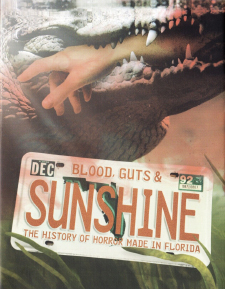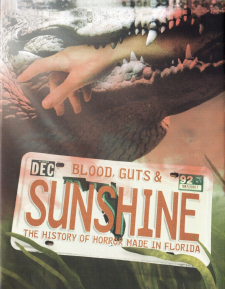Blood, Guts and Sunshine: The History of Horror Made in Florida (Blu-ray Review)

Director
Sean DonohueRelease Date(s)
2022 (October 25, 2022)Studio(s)
Gatorblade Films (Terror Vision/Vinegar Syndrome)- Film/Program Grade: B-
- Video Grade: C+
- Audio Grade: A
- Extras Grade: C-
Review
Though Hollywood is the center of film production and has been for decades, many low-budget and exploitative horror films were made across the country. In his documentary Blood, Guts and Sunshine: The History of Horror Made in Florida, director Sean Donohue introduces us to local filmmakers from the sunshine state and the horror movies made there.
Donohue uses lots of “talking heads”—filmmakers who shot films in Florida, such as William Grefe, Chris Woods, Tim Ritter, Marcus Koch, and Joel D. Wynkoop. There are also interviews with legendary Herschell Gordon Lewis (Blood Feast), who practically created the genre known as horror splatter with graphic images of dismemberment, gushing blood, and torture. Previously a maker of nudie films, Lewis shifted his attention to graphic gore when Hollywood was still hesitant to go that route. After Blood Feast in 1963, such films as Two Thousand Maniacs, Color Me Blood Red, and The Gruesome Twosome followed. Lewis is shown behind the scenes during the making of his last film, The Uh-Oh Show.
The documentary begins with a brief overview of Florida filmmaking prior to the exploitation era with a particular nod to Jack Arnold’s Creature from the Black Lagoon and then concentrates on films made in the 1980s and beyond. Director Donohue, through interviews and film clips, shows how many Florida filmmakers influenced a younger generation. He devotes a special section to Florida TV horror host Dr. Paul Bearer, portrayed by Dick Bennick, Sr., whose Creature Feature is fondly remembered by directors who watched him and were inspired to follow their dream to make horror movies of their own.
There are also fond recollections of a pre-Facebook and pre-YouTube website called Crazed Fanboy run by Nolan B. Canova, who reviewed movies, had discussions with filmmakers, and hosted guest appearances. Considered “ahead of its time,” it was a forum that attracted lovers of low-budget horror.
Grindhouse Video, a small Tampa store run by Mike Standlin, moved to larger quarters, specialized in horror, and stocked VHS, Blu-ray, DVD, LaserDiscs, and collectibles related to the genre. He also expanded into selling online. His store was an oasis for low-budget exploitation films, and served as an inspiration for aspiring filmmakers. In 2021, Standlin moved Grindhouse video to Knoxville, Tennessee.
There are brief appearances by directors John Waters (Pink Flamingos), John Landis (An American Werewolf in London), and Joe Dante (Gremlins) who discuss their connection to the Florida school of moviemaking. Only Waters provides real insight into how his work is connected to Florida horror—“I was making horror for the art house, and the Florida directors were making horror for the grindhouse.”
The documentary is filled with clips from the films being discussed, but Donohue—himself a filmmaker—devotes too much screen time to the often rambling reminiscences of the filmmakers. The subjects speak extemporaneously and, to a regular person, are effusive in their affection for the horror exploitation genre. Obviously, they are passionate about making movies, but more judicious editing of their interviews could have made the point more succinctly. One of the difficulties Donohue may have faced is cramming so much history into a single film. Perhaps breaking his documentary into two parts would have allowed him to cover the directors and key films in greater detail. Because he covers so much territory, the films tend to run together and their distinctiveness is blurred.
Blood, Guts and Sunshine was shot digitally by Sean Donohoe and Chris Woods, who also created the lighting design, for the intended aspect ratio of 1.78:1. There is no specific information on cameras used to film the documentary, but original sources for film clips includes video, 16 mm, and 35 mm. The film comes to Blu-ray for the first time from Terror Vision Records. The visual quality of the documentary varies from crisp, pristine quality interviews shot digitally to film clips that range from below-par to sharp. Director Donohue doesn’t shy away from graphic images, and he includes plenty. The subjects interviewed are mostly filmed with posters, memorabilia, and assorted horror-related items clearly displayed in the background.
The soundtrack is English 2.0 DTS-HD Master Audio. English SDH subtitles are an available option. The interviews are all recorded perfectly, so that we never miss a word. The film clips contain screams, music, liberal sound effects, and bits of dialogue. Outtakes are shown as the closing credits roll. The score by Toshiyuki Hiraoka is upbeat and not typical horror music, capturing the film’s affectionate regard for Florida’s exploitation horror.
Bonus materials include the following:
- Satan’s Children Panel (21:11)
- Grindhouse Video Tour (9:54)
- Scott Tepperman’s Home Video Store (10:06)
- Trailer (1:46)
- Horror Movie Trailers Made in Florida (13:22)
Satan’s Children Panel – This is a reunion of several people who worked on the film Satan’s Children (1975). The participants are actors Rosemary Orlando, John Edwards, David Mendoza, and sound mixer Bill Dudley. The actors discuss their roles and provide brief overviews of their careers. Dudley discusses the limitations of working with not-the-best equipment.
Grindhouse Video – Mike Standlin welcomes us to his video store, Grindhouse Video, as he opens the door. Once inside, the camera roams the aisles, showing the store’s vast collection of videos in many formats, posters, T-shirts, models, comic books, and other collectibles. The wordless tour is accompanied by music.
Scott Tepperman’s Video Store Tour – Unlike the Grindhouse Video tour, this one has owner Tepperman showing us around his small store as he points out the videos, talks about how items are organized, and notes the few collectibles displayed. (He limits collectibles because they take up a lot of space). Tepperman proudly points out working VCR and Betamax players and a 300-pound wooden cabinet TV.
Horror Movie Trailers Made in Florida – Twelve trailers are included: Die, Die, Delta Pi, Amerikan Holokaust, Death-Score Service, Death-Score Service Part 2: The Naked Dead, Taste Me: Death-Score Service Part 3, Chaos A.D., Cannibal Claus, Naughty, Dirty, Nasty, Naked Cannibal Campers, Kill-Cam, The Hart-Break Killer, and Sushii’s Sex Seance.
Blood, Guts and Sunshine is obviously a labor of love from director Sean Donohue. He’s put together a comprehensive look at a horror sub-genre that has never been examined in such detail. The documentary illustrates that guerrilla filmmaking involves hard work, ingenuity, and passion.
- Dennis Seuling

